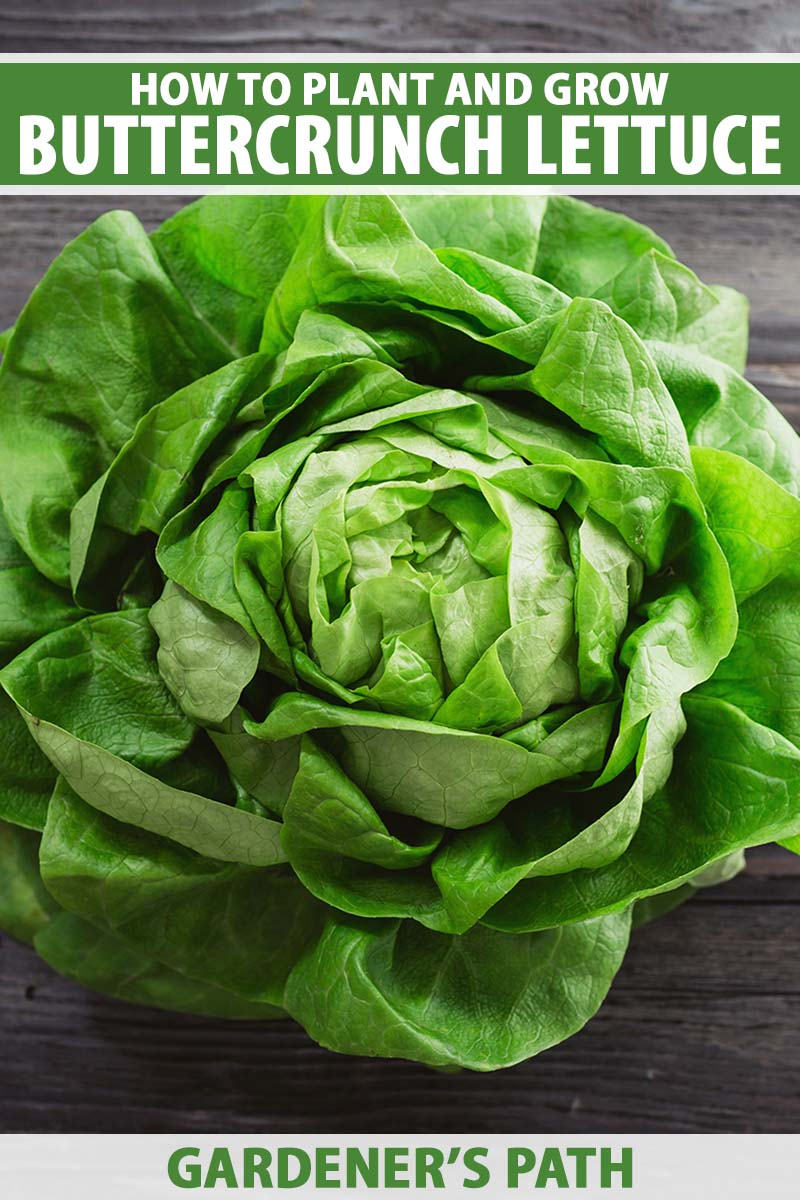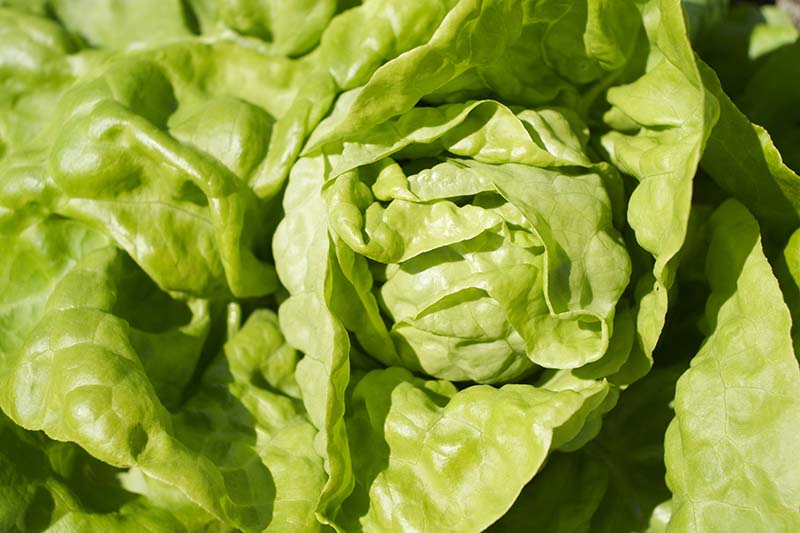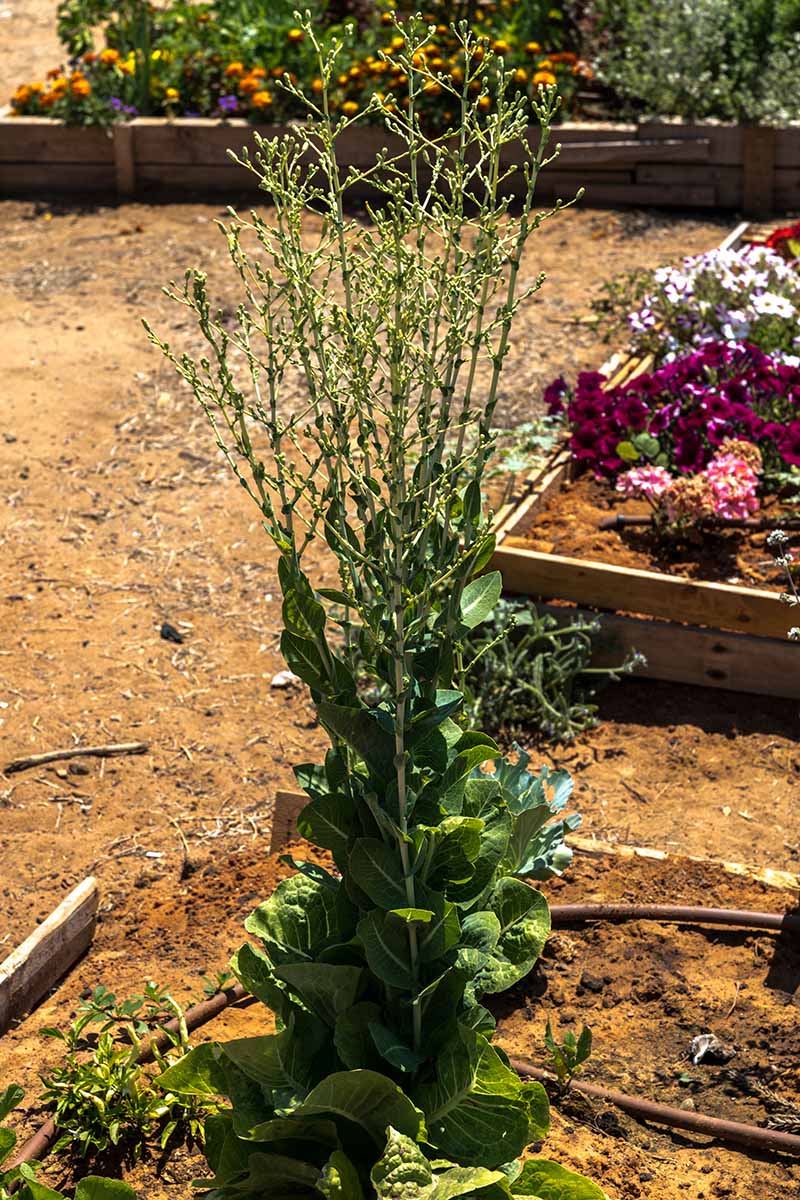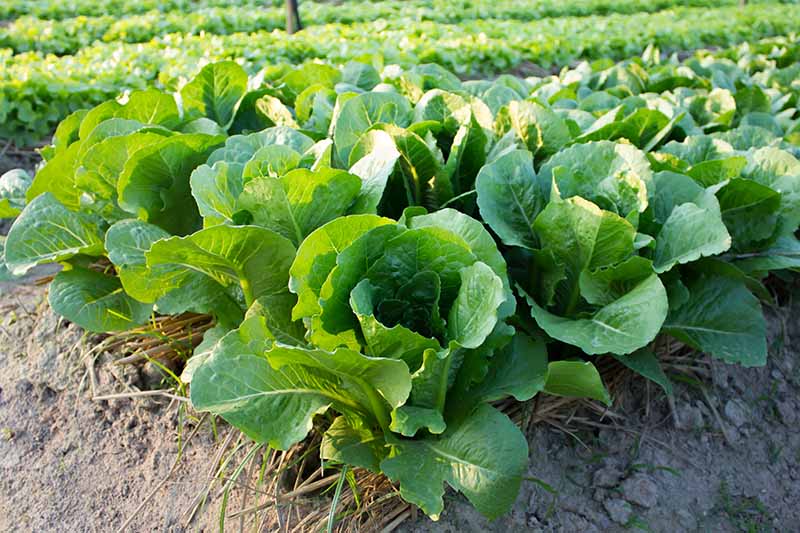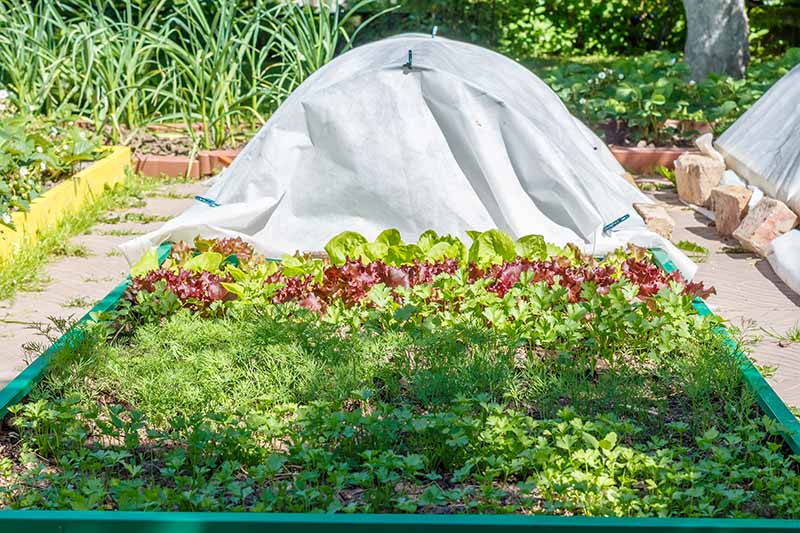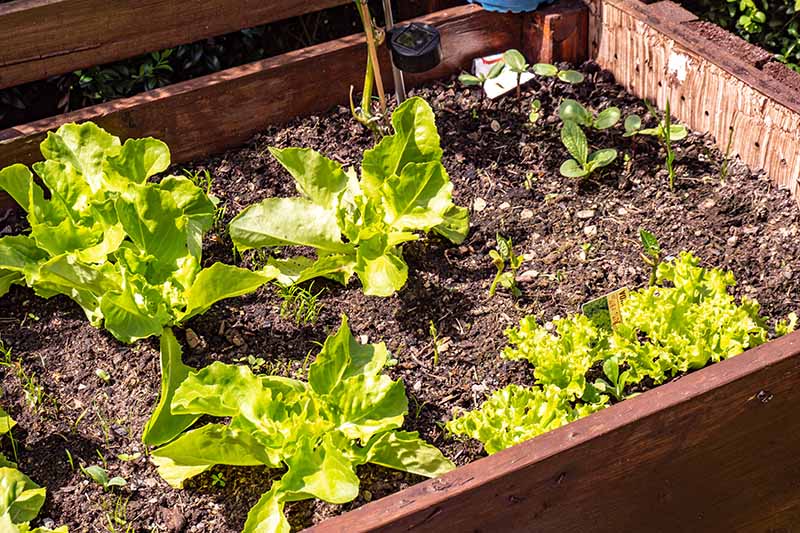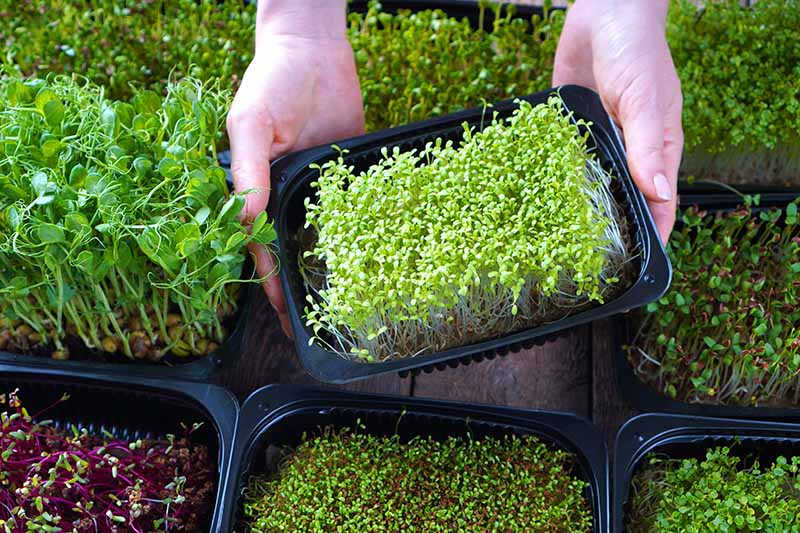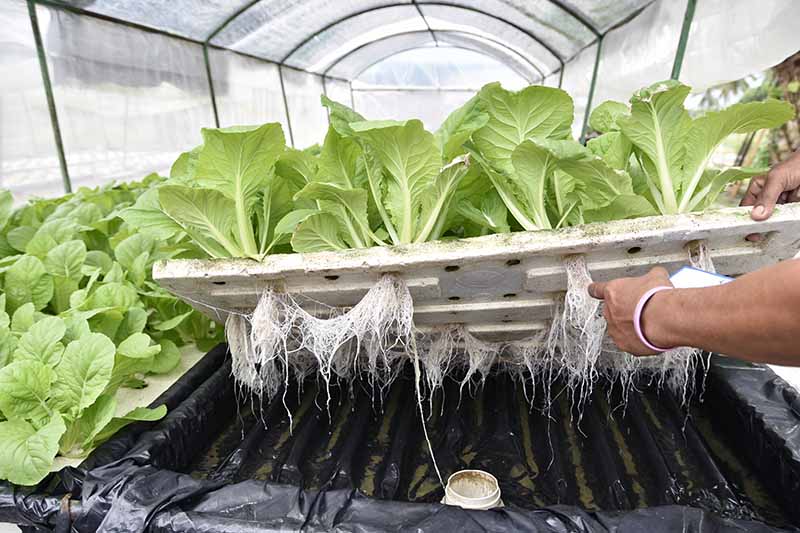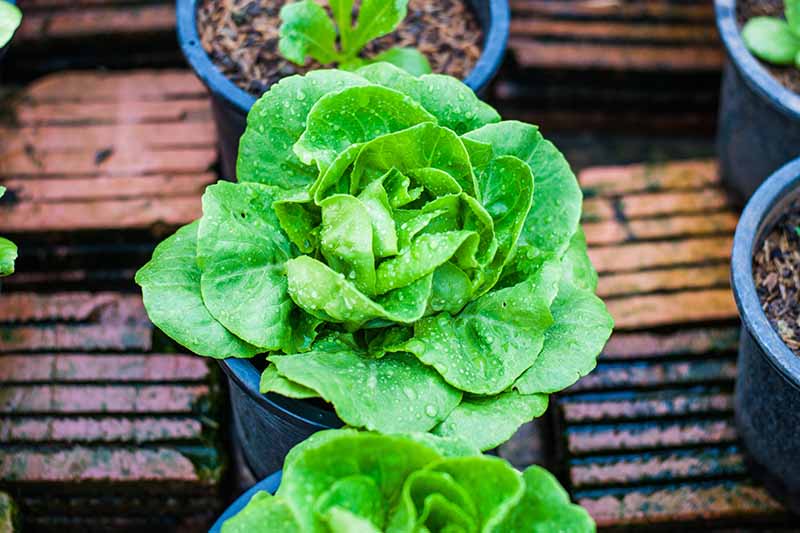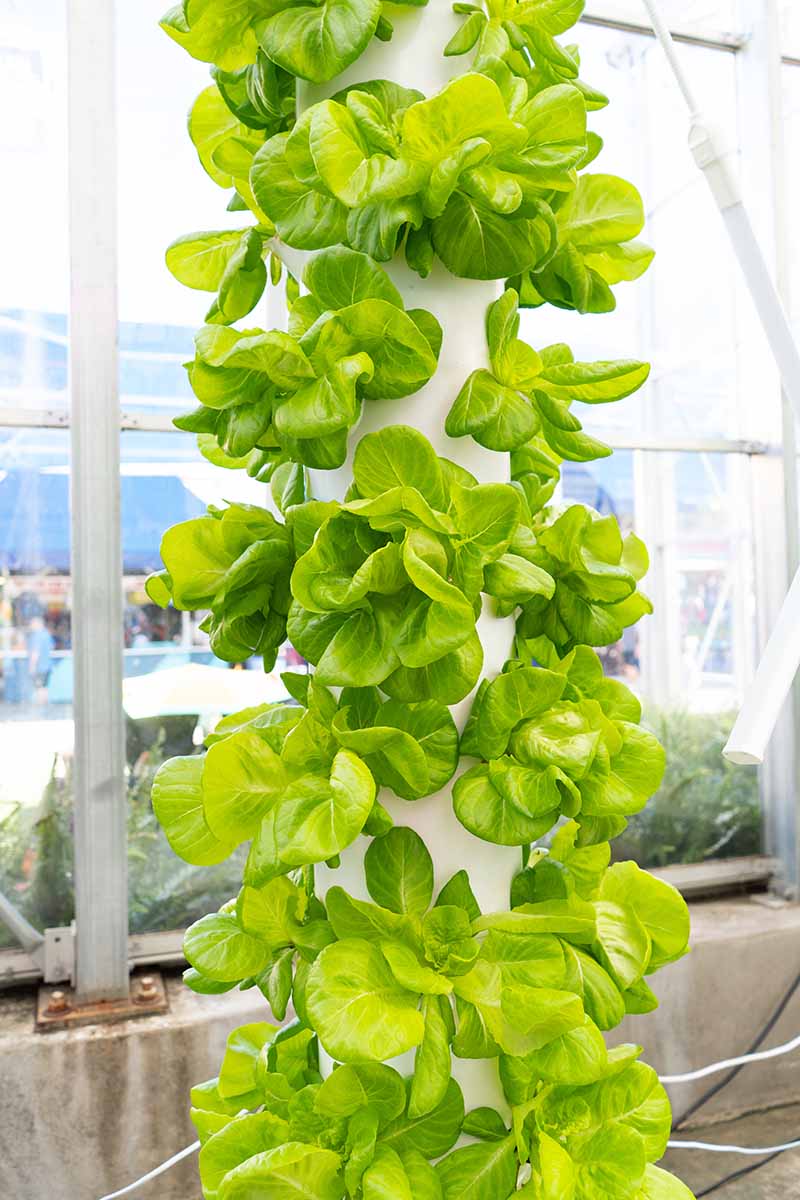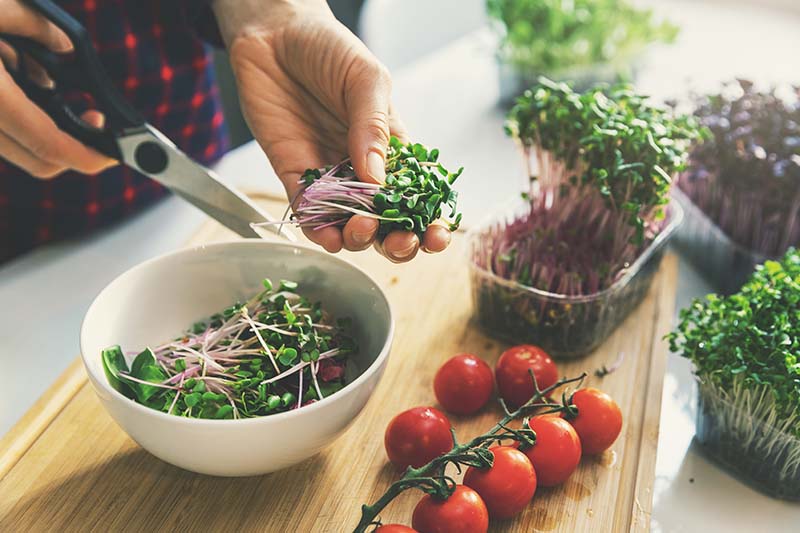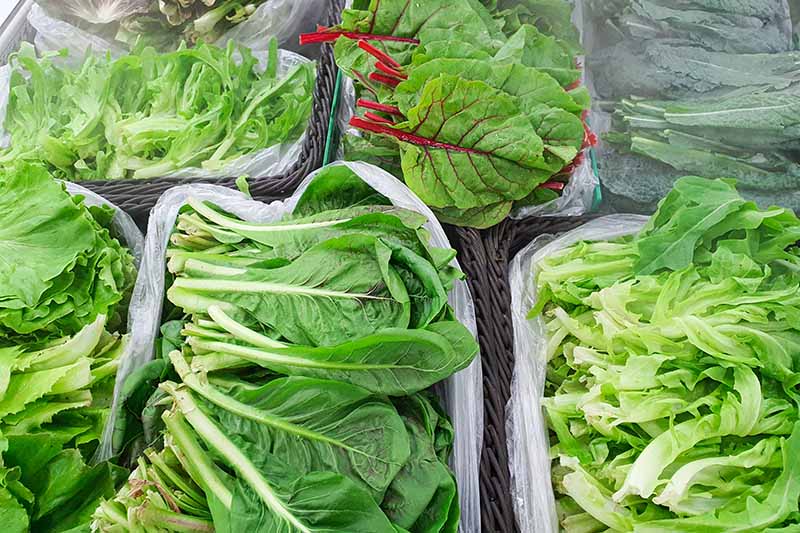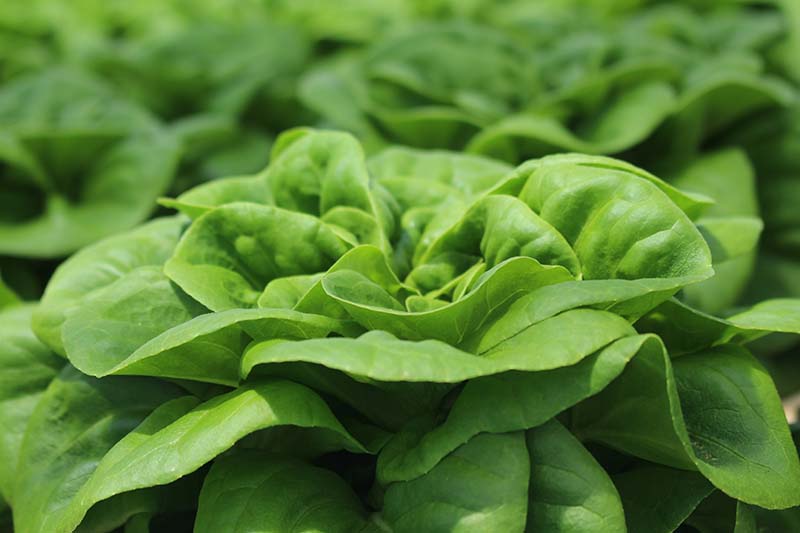Any time the word “butter” appears in the name of a vegetable, you know you’re in for a treat. Buttercrunch belongs to a category of lettuces known as “butterheads,” including other varieties such as ‘Boston’ and ‘Bibb,’ which all feature similar characteristics. We link to vendors to help you find relevant products. If you buy from one of our links, we may earn a commission. Whereas ‘Iceberg’ has a sharp crunch and thick leaf texture, ‘Buttercrunch’ has thinner leaves and a softer, more velvety texture that is perfect to top sandwiches, roll up in wraps, and even substitute for tortillas. The flavor is milder than that of many of the other loose-leaf varieties, making it a preferred choice when the crunch and taste of greens is desired without imposing bitterness. However, ‘Buttercrunch’ is more tolerant of heat than some types, making it a good addition to gardens in warmer climates. When other varieties are bitter and bolting, buttercrunch holds out. Let’s talk about what it takes to grow buttercrunch lettuce!
Cultivation and History
The first lettuce in cultivation originated in the Middle East. The plants were bred from wild specimens that were taller with a structure comprised of individual leaves, similar to the romaine variety. The ancient Egyptians were the first known civilization to use lettuce for food, oil, and medicine and cross-bred plants to develop sweeter, more palatable varieties. From the Egyptians, the Romans learned to cultivate lettuce, which became a common part of the Roman diet. As popularity spread, new varieties of lettuce were developed in Europe and Asia, eventually travelling to the American colonies. Over time, this versatile plant became a part of gardens all over the world. Butterhead lettuces, such as ‘Boston’ and ‘Bibb,’ differ from crisphead varieties, such as ‘Iceberg,’ in that butterheads form loose, soft heads that can be harvested as individual leaves, rather than entire heads, throughout the growing season. ‘Buttercrunch’ lettuce is a butterhead variety that was developed by George Raleigh, a professor at Cornell University who specialized in vegetable crops. While it’s not considered an heirloom, it’s an award winning cultivar that has been a staple garden lettuce since the early 1960s. Because of the soft, buttery texture, this variety has long been considered a standard addition to sandwich and wrap recipes. Heads of this variety, as with almost any loose-leaf lettuce, can be left at the end of the growing season to bolt, or bloom, to produce seed. Collecting your own seed is a wise way to propagate plants most suited for your garden and hand-select those with the best characteristics. One head of lettuce can produce hundreds of seeds, and serve as parent to crops for multiple growing seasons.
Propagation
Most gardeners try their hand at growing lettuce at some point, and many choose to include it in their garden every year. It’s one of the most common additions to the garden and, in most cases, pretty simple and straightforward to grow, with good results. In about two months’ time, you can begin harvesting your first crop of ‘Buttercrunch.’ Plants can be direct sown, started indoors and transplanted, or grown in containers. Lettuce is also highly successful when grown in aquaponic or hydroponic systems. Lettuce seed is small and fine, resembling chaff. If you decide to collect your own seed from plants in your garden, you may be fooled into thinking that the dead blooms have not produced any because it’s so hard to see! An important consideration to make before planting ‘Buttercrunch’ is that mature heads will typically be six to eight inches wide, and sometimes larger. Allow adequate room for spacing.
From Seed
A flat of one-inch cells is adequate for lettuce starts as they do not require much room to root. When starting seeds indoors in flats or pots, you’ll want to choose compost or a potting mix that is nutrient dense. A blend that includes aged manure works well to increase available nutrients for healthier plants. Similarly, amending the soil at the growing site with compost or aged manure prior to planting is best when direct sowing seeds. Avoid overwatering or allowing soil to become soggy as this can cause rotting, especially with sensitive lettuce. Keep a close eye out for fungus gnats or signs of damping off as well, as both can kill delicate sprouts. Lettuce is typically tolerant of cooler temperatures, so plan to start seeds indoors a few weeks before the last frost for your area. Early spring or early fall are ideal times for planting, but be sure to allow enough time for plants to mature before the first frost – about 60 days. If you choose to start seeds outdoors, wait until the threat of frost has passed and sow directly in fertile soil, preferably at a site with partial shade. Be sure that the ground has thawed if you’re gardening in an area where it freezes in winter. Sow seeds about one-eighth of an inch deep, spacing plants at least ten to twelve inches apart. If you plant them closer together, you’ll need to thin them out after they sprout by choosing the healthiest, fastest growing plants and plucking the ones that don’t make the cut. Seedlings need light to germinate, so avoid planting too deeply. Keep the soil consistently moist, but not wet. Seedlings should emerge in one to two weeks. They’re initially small and weak, and extremely susceptible to sunscald, which can cause them to wilt and die in just a few hours. It may be necessary to protect seedlings with shade cloth, or row covers such as tunnels, to prevent them from being sun damaged. Tunnels can serve double duty by offering protection from animal and insect damage as well. Most heads will reach maturity in as little as 50 to 60 days, so it’s possible to plant several crops in succession throughout the growing season.
From Seedlings/Transplanting
Lettuce seedlings are delicate and small, with a shallow root system. When seedlings are about three to four weeks old, they can be moved outdoors in temperatures as low as 20°F, although it is generally best to avoid transplanting until temperatures are above freezing. Transplants should be hardened off by reducing the amount of water they receive and gradually introducing them to more indirect sunlight for one to two weeks before moving them outdoors permanently. Soil at the planting site should be rich and fertile, and amending with compost or aged manure ahead of time will help seedlings get the best start possible. Arranging seedlings in slightly mounded rows, spaced about one foot apart, can provide good drainage and keep leaves from coming into contact with the ground, which can cause them to rot and make it easier for pests to infest them. Dig holes as deep and wide as the planting cell, and space plants ten to twelve inches apart. Place the seedlings in the holes, press down with your hands, and water to settle. As plants are harvested, new plants can be transplanted to the same growing site provided that disease or pest infestation have not been problems. Plan to plant a new crop every 60 days and start seeds accordingly.
How to Grow
‘Buttercrunch’ forms loose, soft heads of leaves that are slightly more tolerant of heat than some varieties. Consistent watering is important, although it’s not a good idea to drench the soil as lettuce can rot if kept too wet. About one to two inches per week is recommended during the season. If you aren’t sure how much your garden is getting from precipitation, try using a rain gauge. If the soil dries out too often, ‘Buttercrunch’ and other types of lettuce can become stressed, leaving them open to damage from disease and pests. Drip irrigation can be an effective solution to provide moisture without drenching, and it can also prevent the spread of some types of disease. To keep soil consistently moist, a light layer of mulch can be added, however, avoid allowing soil or mulch to come into contact with the lower leaves, as this can also cause rotting. Leaves that show signs of rot, such as brown or yellow blotches, or a mushy, wilted texture, can be removed and discarded before they affect other adjacent parts of the head. Fertilizer isn’t really necessary if the soil your lettuce is planted in is healthy and rich in organic material. If you want to give an added boost, fertilizers such as fish emulsion, or others that are low in nitrogen, can be beneficial. Use fertilizers sparingly as lettuce has a small and delicate root system that can be damaged easily by over-application. In times of high heat, such as the summer months, pay careful attention to your plants. Signs of sunscald include wilting, and burns that appear bleached and brittle. Protect ‘Buttercrunch’ plants from heat and sun exposure by covering them with shade cloth, row covers, or polytunnels, or plant near other taller plants such as tomatoes or peppers that can provide some shade. Row covers or polytunnels not only diffuse light, they can also protect from foraging animals and infestation, as well as from low temperatures and frost. Lettuce seedlings are more tolerant of cold and freezing than more mature plants, so it’s also important to protect heads from extreme cold. Cold frames are structures that are built to create enclosed growing environments, protecting plants inside from exposure to cold temperatures while still allowing full sun exposure and the benefit of growing in-ground. A cold frame traps heat from the sun and the warm, moist air that transpires from the ground, as well as from plants and decomposing material, offering a warm place to grow when it’s cold outside. They can be used to extend the growing season through winter in areas where low temperatures are not extreme, and may be planted with suitable companion plants as well. A cold frame can be built simply by using four one-by-four-inch boards positioned in a square or rectangular pattern, fastened together at the corners with screws and brackets.
Container Growing
‘Buttercrunch’ lettuce is an excellent choice for container growing. In a relatively small space, over the course of a few months, you can produce more than one crop with the added benefit of mobility. Portable Wooden Cold Frame Plants in containers can be moved indoors or to a controlled environment, and protected from infestation, foraging animals, and damaging weather conditions.
Trays
There are two reasons that ‘Buttercrunch’ lettuce could be grown in a tray. Fresh fodder is highly nutritious and can be fed to chickens and other small livestock to improve their diet, replace dry grain, and supplement feed in the winter months. These are delicious and tender, and can be used in recipes just as you would mature lettuce. Self-Watering Grow Trays Self-watering grow trays can be used to produce a small quantity of plants, such as these which are available from True Leaf Market. Or choose a larger tray to produce a greater quantity, such as this one, also available from True Leaf Market. Microgreens contain a lot of nutrients and water, and the flavor of young ‘Buttercrunch’ sprouts is sweet and mild, which can add an interesting boost to a variety of recipes. See the recipes section below for some ideas. Planting ‘Buttercrunch’ seeds in a tray can also produce homegrown fodder for chickens. Lettuce seed can be mixed with other types of seeds, such as beets, cabbage, and kale, to create a kind of “fodder salad,” which can be grown and then harvested and placed in your chicken enclosure at feeding time. True Leaf Market has a fantastic selection of seed that is tried and true for producing microgreens.
Aquaponics or Hydroponics
Aquaponic and hydroponic systems use water as the planting medium for a wide variety of plants, including strawberries, lettuce, and many more. When planting in trays, monitor sprouts to be sure that mold is not growing between the closely-growing plants. Terrafiber Hemp Grow Mat ‘Buttercrunch’ is a perfect addition to either system, as the shallow roots and short period of time to maturity work well for this method of growing. Systems such as these that use water as the growing medium are set up in a number of ways, such as with water tanks, plastic tubes, or sometimes uniquely constructed structures, all allowing plant roots to come into contact with water. The difference between aquaponics and hydroponics systems is that hydroponics uses only water with liquid nutrients added for growing, while in aquaponics, containers of water house fish, which provide nutrients from waste dissolved in the water. ‘Buttercrunch’ heads grown commercially in these systems are often sold in grocery stores.
Pots and Window Boxes
‘Buttercrunch’ lends itself well to container growing because of its small, shallow root system and relatively simple needs. A window box or small planter is perfectly adequate for growing a few heads at a time, and can be reused as often as you like. Add compost or fish emulsion to increase available nutrients during the growing season, and replace the soil every two to three years to keep it fresh and healthy. Any time you’ve had a bout of disease or infestation in a container, empty the contents, disinfect the container by soaking in a solution of one part bleach to nine parts water, or substitute vinegar for bleach in a ratio of one part vinegar to three parts water, and leave the container submerged overnight. Remove the container from the solution, rinse well, and allow it to dry completely before proceeding to use it for planting again. Be sure to check in crevices and under rims for any remaining pests, eggs, or residue. Be sure that the chosen container drains well, and keep the soil moist but not wet. ‘Buttercrunch’ grown in containers will still need adequate sunlight, so be sure that plants are getting at least six to eight hours of light per day. Full sun is preferred, although plants should be protected if temperatures are high, such as in the dead heat of summer. By planting vertically, you can potentially grow dozens of plants in a season using a four- to six-foot-tall growing tower, which takes up just a few square feet of horizontal space. Vertical Garden Planter This is achieved by arranging rows of plants vertically, rather than planting horizontally, and is also known as growing “up, not out.” Towers can be positioned on a deck, porch, or even indoors in some instances. Some towers are lightweight enough to be portable, moving indoors easily during heatwaves or cold snaps, and extending the growing season. Grow towers can sometimes be used in conjunction with an aquaponics system, or planted with soil as the growing medium.
Growing Tips
‘Buttercrunch’ seeds can be started indoors or direct-sown after the threat of frost has passed.Spring or fall are ideal growing seasons to protect lettuce from high or low temperature extremes.Plants should be protected from sunscald with row covers or tunnels.Cooler seasons and partial shade are better for ‘Buttercrunch,’ as heat encourages bolting and bitter flavors.
Managing Pests and Disease
Lettuce can be a magnet for pests, large and small. ‘Buttercrunch’ Eden Brothers sells ‘Buttercrunch’ seeds in a variety of packet sizes and in bulk. Deer enjoy munching on the tender leaves and rabbits like to demolish young plants. A variety of different insects may infest your ‘Buttercrunch,’ from the ever-present aphid to caterpillars, flea beetles, and fungus gnats. Many of these common pests can contribute to the spread of disease as well. Slugs and snails enjoy making a meal of your lettuce and will create telltale ragged holes in the leaves as they feed. A large infestation can decimate your crop. You can learn more about how to manage lettuce pests in our full guide. Almost all garden plants are susceptible to some kind of disease, and ‘Buttercrunch’ is no exception. Seedlings that suddenly die may be suffering from damping off. Downy mildew is a fungal infection that can cause the leaves to develop a fluffy mold on the underside of the leaves. Another fungal infection is bottom rot, caused by various species of fungi in the Rhizoctonia genus that live in the soil. Bacterial leaf spot shows up as black lesions on the outer leaves and if allowed to spread, can destroy your entire crop. Check out our guide to common lettuce diseases to learn more.
Harvesting
There are a few different ways to harvest ‘Buttercrunch’ lettuce, depending upon how you plan to use it. Microgreens can be ready to harvest in as little as a few days or up to about two weeks. Use a sharp knife or scissors to cut the sprouts close to the root by the handful, or simply brush off the seed coats and use the entire sprout. Immediately after harvesting sprouts, refrigerate them to keep them fresh. Be prepared to use them within a few days to a week maximum, because they don’t have a long shelf life. Individual leaves can be cut from lettuce in the garden or in containers any time after a head has formed. Always cut leaves from the outside first, because leaves cut from the inside of the head will not regenerate. Harvesting individual leaves is a good way to keep plants growing through the season if you don’t plan to plant more than one crop. It’s also a good way to allow plants to continue their life cycle if you plan to collect seed from them. Bear in mind that you do not want to remove more than a few leaves at a time from each head if you go this route, as removing too much can kill the plants. Cut leaves can be stored in the refrigerator, typically for up to a few weeks. I prefer to store them in a zipper-sealed plastic bag with a paper towel to collect moisture and prevent wilting. Full heads can be harvested at any time through the growing season. You may choose to cut the head from the stem, or pull the entire plant up by the roots. If you plan to plant more than one crop of ‘Buttercrunch’ per season in the same plot, harvesting the entire plant – roots and all – is best, especially if you’ve had any soilborne disease issues. Harvested heads can be stored in the refrigerator for one to two weeks, especially if the roots are kept intact. Heads can be stored in the refrigerator, in a bowl with a small amount of water at the bottom as this provides moisture for the roots, keeping the head fresh. Heads can also be stored with a wet paper towel in a gallon-sized zipper-sealed bag, or separated into leaves, washed and dried, and kept in a ventilated lettuce keeper in the fridge. It’s best to keep your harvested ‘Buttercrunch’ covered to prevent the potential buildup of bacteria from contact with other items in the refrigerator.
Recipes and Cooking Ideas
On a hot summer day, there is no more delicious and refreshing meal than lettuce wraps. ‘Buttercrunch’ is the perfect type for wrapping up a variety of fillings, such as these Asian-inspired spicy ground beef lettuce wraps from our sister site, Foodal. It can be used as an edible plate for cold salads, such as tuna fish or chicken salad, or the leaves can be used to wrap these salads, replacing a tortilla or bread. This is a good choice for those who prefer to limit their bread or grain intake. Leaves can also be shredded and used as a topping for a variety of foods, such as tacos and burritos, or torn apart and used to replace ‘Iceberg’ or other varieties in any salad recipe. Microgreens are nutrient-dense and excellent for adding a satisfying crunch and vibrant color with a mild flavor. Add a handful as a topping in recipes such as this easy, light sprouts, avocado, and cheddar sandwich, also from our sister site, Foodal.
Perhaps you’ve got a number of varieties on your planting list because you’re a true salad connoisseur, or maybe you’re brand new to gardening and looking for an easy, productive crop. No matter what your plans are, ‘Buttercrunch’ is the perfectly versatile go-to you’re sure to choose over and over again once it becomes a favorite. And it can be a part of your garden year round, with a little necessary preparation. What method will you use to grow ‘Buttercrunch?’ Will you plant it in the ground, in a pot, or in a hydroponic system? Let us know in the comments! We love to hear about your garden adventures! If you’re looking for more information about other types of lettuce and how to grow them, these articles may be useful:
How to Be Successful with Your Lettuce Patch29 of the Best Lettuce Varieties For Your GardenGrow Leaf Lettuce: Harvest Beautiful, Nutritious Salads from Your Own Backyard
